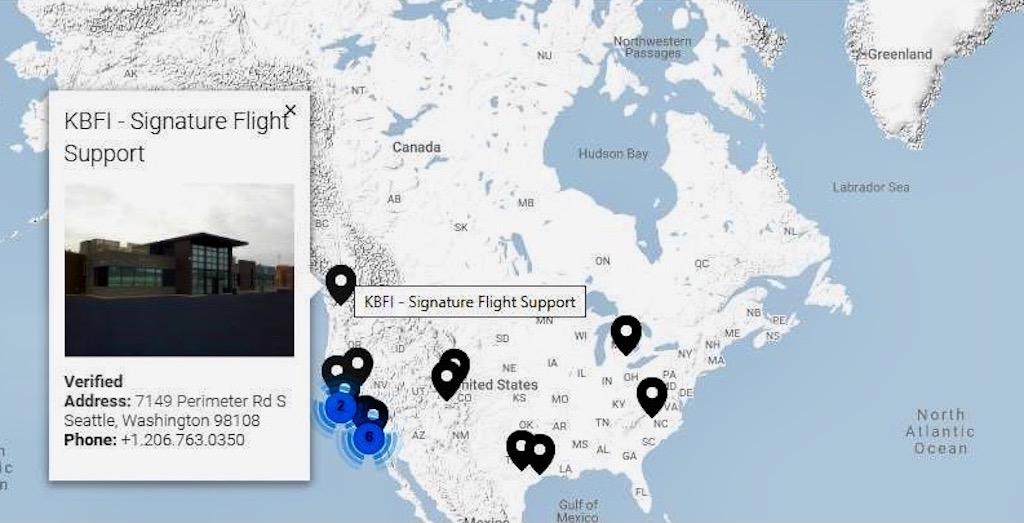
Signature Flight Support parked a SAF truck on the exhibit floor at NBAA-BACE 2022 in Orlando.
Service providers are making progress in raising awareness and sparking demand for premium-priced SAF in business aviation, but the heavier lift is upstream, on the supply side.
The SAF distribution network in the U.S. is anchored in California, and many of the FBOs that supply SAF are clustered there and along the West Coast. Industry sources attribute the concentration of FBO locations to California’s Low Carbon Fuel Standard (LCFS), an emissions trading scheme that incentivizes the production and use of low-carbon transportation fuels, and physical proximity to the fueling infrastructure.
“The reason why it’s in California today is because of the California LCFS,” says Beatrice Batty, Signature Flight Support director of fuel operations. “That makes [SAF] more economical, and consequently the production has been moved there. As other states and the federal government bring in more incentive programs, we’re going to see more of these projects move elsewhere. There are projects that are starting to be built elsewhere in the country; they’ll be disadvantaged in price from the California product because the [fuel] has to be used in California to take advantage of the LCFS.”
The Neste fuel Signature is providing is a 70/30 blend of conventional jet fuel to SAF, within the 50% SAF limit allowed by ASTM commercial specification.
“There are some aircraft, usually [with] older engines and airframes, that require certain components—aromatics—of fossil-based jet fuel to maintain the health of the seals in the engine,” Batty explains. “You can go up to 50% [SAF content] but it’s also a challenge to get the right type of jet fuel that has a high enough quality to blend when you’re ready to put it into aircraft.”
Neste’s Lana Van Marter adds: “In certain cases, when the fossil fuel has the characteristics that we can blend it and hit all the chemical characteristics that you need for the older aircraft, we can go as high as 40% [SAF content]. But that is very rare at this time. The average would be like 35-37%. It really depends on the quality of the jet fuel we have to blend with sustainable aviation fuel.”
Other than FBOs directly pumping sustainably sourced jet fuel, “book-and-claim” programs are the industry’s mechanism for sparking demand. Through book-and-claim, an operator flying from an airport that does not supply SAF on site can purchase—or book—a specific quantity of fuel from an FBO that does provide SAF, pay the premium, and claim an emissions reduction credit. The FBO accounts for that quantity and delivers an equivalent amount of SAF elsewhere in the supply chain.
“It’s really going to be the advent of book-and-claim that is going to bring availability to locations beyond California,” says 4AIR President Kennedy Ricci. “It’s more economical, it’s more sustainable to keep it in the state. I don’t think we’ll see a huge explosion of physical supply outside of California for probably several years, until we get production outside of California,” says Ricci
Blenders Tax Credit

In August, the U.S. Congress passed the Inflation Reduction Act of 2022, which contained a Blenders Tax Credit that business aviation had long advocated to incentivize SAF production. The tax credit is valued at $1.25-$1.75 per gal. of SAF sold, depending on the percentage of lifecycle greenhouse gas (GHG) emissions reduced compared to fossil-based jet fuel. The credit is effective until January 2025. After that date, a new Clean Fuel Production Credit that expires in December 2027 will allow up to $1.75 per gallon for SAF with a 100% GHG reduction compared to a baseline emissions factor.
“The tax credit for SAF helps level the playing field with more established biofuels and sends the right signal to investors to attract that capital that is needed,” to build out the distribution network, says Megan Eisenstein, managing director of industry and regulatory affairs with the National Air Transportation Association.
Ricci believes the Blenders Tax Credit will boost SAF availability indirectly, by making it more affordable for aircraft operators. “It’s really about making it easier for adoption,” he says. “The Blenders Tax Credit is going to reduce the net cost to the end customer; in turn that’s going to allow for more adoption, and that’s going to show there is more demand. The tax incentive helps spur the momentum for SAF through the next few years by showing the demand for it, getting beyond the early adopters to a wider audience.”
In Part 3 of this article, we describe the looming competition for sustainable feedstocks.
SAF Must Be Scaled To Meet ‘Net-Zero’ Pledge, Part 1: https://aviationweek.com/business-aviation/airports-fbos-suppliers/saf-…

